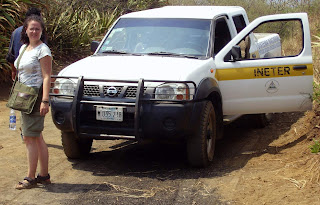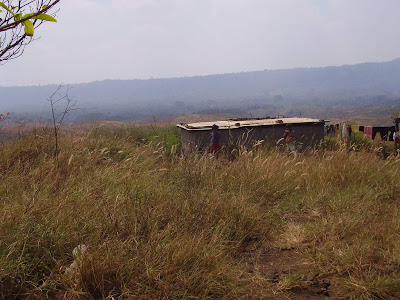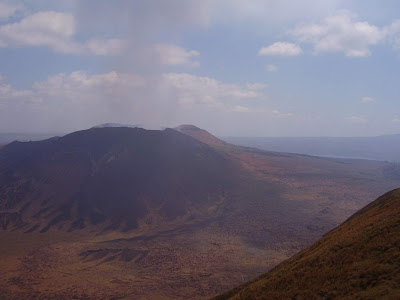My Way
So, here is a bird's eye view on my daily route (9,89 km from my apartment in a town to the last houshold I visited. Wow! How did I manage this?!??)


Sense dependency vs. information dependency. Can phenomenological perspective be united with Beck’s theory of risk society?

 People themselves while talking about this place don’t use a term “village” neither. One of the habitants tell me: “We are not a village like you can see other places. There is one house here, one house there. I don’t know how to call it (…) They say comarca (region) or just comunidad (community), but I don’t know (…) No, we’re not living together like this [when I explained how the most villages look like (or what is MY image of them)]. It’s because of the mountains…”. And this pattern of settlement is surely common in other mountainous regions.
People themselves while talking about this place don’t use a term “village” neither. One of the habitants tell me: “We are not a village like you can see other places. There is one house here, one house there. I don’t know how to call it (…) They say comarca (region) or just comunidad (community), but I don’t know (…) No, we’re not living together like this [when I explained how the most villages look like (or what is MY image of them)]. It’s because of the mountains…”. And this pattern of settlement is surely common in other mountainous regions.


To make things clear – I don’t live in the X which is situated about 7 kilometres from where I live and this also has consequences in the way I conduct my work. This can be also the reason of the problems I described in the last post. I think this subject deserves separate post, but I need to spend more time with these people to see how being non-live-in guest from the town influences our relations.


So, I can’t say that I am doing the typical fieldwork “round a bonfire” (H. Wike) that gathers villages members that are connected by a net of complex relations. Surprisingly, people that have the same experience (the destroying influence of the Masaya volcano) can live so separately and within one’s own family. They say so themselves: “No, we’re not living much together (…) we like each other, but we don’t have time to visit. And we like to spend time with our families”. It’s also amazing how many different ideas about the volcano, health, poverty and life in general can be found up there in the hills.
The fact that I’m not living there, the landform features and the transportation “problem” makes my visiting time highly limited. And I don’t live their life 100 % like the “traditional fieldwork” likes to demand.



What is the best way to learn riding?
I had never before mounted a Nicaraguan horse. I had never before ridden any horse! I had never climbed a mountain on a horse! I had never before climbed a volcano on a horse!!! What an experience! Telica volcano reached! Generally speaking I’m afraid of animals and have a little fear of heights and I don’t know how I survived this most extreme riding school! It was fun, but after 6 hours there was only weeping and gnashing of teeth! :) The local farmer took no notice of my pain, tears and frustration, just making fun of us by showing the acrobatic manoeuvres on his animal. But the view was worth it.



(How did they do this??!!)







(view on the San Cristobal -the highest volcano in Nicaragua)







(But I survived...)

 And after all I managed to talk a little bit with our “teacher” about the volcano and hot springs San Jacinto.
And after all I managed to talk a little bit with our “teacher” about the volcano and hot springs San Jacinto.




I was also satisfied with the visit at San Jacinto village. Again, after reading some materials about these hot springs (connected to Telica volcano and emitting SO2) I thought also about going over this place with a toothcomb, but one geologist I had talked to said that San Jacinto was so local phenomena that I could be disappointed by doing research there (he also wondered if there was any point doing fieldwork there – well, I thought about the words on the website of my university that says: no ecosystem is too small to being investigated. I think these words are also relevant for any group, community and even relation). And he was right. There are a few families that are living near Hervideros de San Jacinto and the SO2 isn’t so unbearable as I had supposed after reading the reports. It’s also a finding one could say :)
It was also funny to read danger plates round the village that says like this one: “Be careful. There are dangerous places at the hot springs. Please use a guide!”. Being a guide round the hot springs is almost the only source of income for the local. Playing with a fear?

 Yesterday I found two reports about the Masaya volcano. One made by INETER in 1990 and the other from 1999. I paste a map from 1990 that shows the area of the gas emission from this volcano. I don’t have tools, so the look is a little bit clumsy, but it illustrates what I want to show. The orange means the area most affected by the gases. We are not living there (firstly, on account of our health and secondly, it’s not easy to find an accommodation there). We’re living in an area of “medium risk” as the map states (I’m not yet 100 % if I marked our location correctly). People here say that it’s only a few times a year that the wind changes and the gases come to La Concha. “Then you just close the windows and don’t go out” (said a lady who owns windows! There are not much of them here).
Yesterday I found two reports about the Masaya volcano. One made by INETER in 1990 and the other from 1999. I paste a map from 1990 that shows the area of the gas emission from this volcano. I don’t have tools, so the look is a little bit clumsy, but it illustrates what I want to show. The orange means the area most affected by the gases. We are not living there (firstly, on account of our health and secondly, it’s not easy to find an accommodation there). We’re living in an area of “medium risk” as the map states (I’m not yet 100 % if I marked our location correctly). People here say that it’s only a few times a year that the wind changes and the gases come to La Concha. “Then you just close the windows and don’t go out” (said a lady who owns windows! There are not much of them here).






Do you see the gas plume?

(No, it´s not so bad quality of the pictures, it´s a cloud of volcanic gases)
Later, when I asked one person about why there is no medical investigation done there, he laughed and said that “maybe because they want people to die calm”. I don’t know if it’s true that nobody makes research in this zone. Tomorrow I have a meeting with somebody from the Medical Department at the UNAN (University in Managua) and will surely ask:).
Anyway, we came back home to Leon and packed our stuff (God, how much I managed to collect in one month!!!) and moved to Masaya that is about 120 km from our previous location. Next day we went round the volcano and find a room in La Concepción (popularly known as La Concha) that is about 10 km from the maximal affected zone. Finally I feel that my work has began, although I am still a little bit confused what my next step should be, but I’m really excited and I feel that this place is a right one for us.



Momotombo
El tren iba rodando sobre sus rieles. Era
en los días de mi dorada primavera
y era en mi Nicaragua natal.
De pronto, entre las copas de los árboles, vi
un cono gigantesco, "calvo y desnudo", y
lleno de antiguo orgullo triunfal.
Ya había yo leído a Hugo y la leyenda
que Squier le enseñó. Como una vasta tienda
vi aquel coloso negro ante el sol,
maravilloso de majestad. Padre viejo
que se duplica en el armonioso espejo
de un agua perla, esmeralda, col.
Agua de un vario verde y de un gris tan cambiante,
que discernir no deja su ópalo y su diamante,
a la vasta llama tropical.
Momotombo se alzaba lírico y soberano,
yo tenía quince años: ¡una estrella en la mano!
Y era en mi Nicaragua natal.
Ya estaba yo nutrido de Oviedo y de Gomara,
y mi alma florida soñaba historia rara,
fábula, cuento, romance, amor
de conquistas, victorias de caballeros bravos,
incas y sacerdotes, prisioneros y esclavos,
plumas y oro, audacia, esplendor.
Y llegué y vi en las nubes la prestigiosa testa
de aquel cono de siglos, de aquel volcán de gesta,
que era ante mí de revelación.
Señor de las alturas, emperador del agua,
a sus pies el divino lago de Managua,
con islas todas luz y canción.
¡Momotombo! -exclamé- ¡Oh nombre de epopeya!
Con razón Hugo el grande en tu onomatopeya
ritmo escuchó que es de eternidad.
Dijérase que fuese para las sombras dique,
desde que oyera el blanco la lengua del cacique
en sus discursos de libertad.
Padre de fuego y piedra, yo te pedí ese día
tu secreto de llamas, tu arcano de armonía,
la iniciación que podías dar;
por ti pensé en lo inmenso de Osas y Peliones,
en que arriba hay titanes en las constelaciones
y abajo dentro la tierra y el mar¡
Oh Momotombo ronco y sonoro! Te amo
porque a tu evocación vienen a mí otra vez,
obedeciendo a un íntimo reclamo
perfumes de mi infancia, brisas de mi niñez.
¡Los estandartes de la tarde y de la aurora!
Nunca los vi más bellos que alzados sobre ti,
toda zafir la cúpula sonora
sobre los triunfos de oro, de esmeralda y rubí.
Cuando las babilonias del Poniente
en purpúreas catástrofes hacia la inmensidad
rodaban tras la augusta soberbia de tu fuente
eras tú como el símbolo de la Serenidad.
En tu incesante hornalla vi la perpetua guerra,
en tu roca unidades que nunca acabarán.
Sentí en tus terremotos la brama de la tierra
y la inmortalidad de Pan.
¡Con un alma volcánica entré en la dura vida,
Aquilón y huracán sufrió mi corazón
y de mi mente mueven la cimera encendida
huracán y Aquilón!
Tu voz escuchó un día Cristóforo Colombo;
Hugo cantó tu gesta legendaria. Los dos
fueron como tú, enormes, Momotombo,
montañas habitadas por el fuego de Dios.
¡Hacia el misterio caen poetas y montañas;
y romperáse el cielo de cristal
cuando luchen sonando de Pan las siete cañas
y la trompeta del Juicio Final!
Rubén Darío